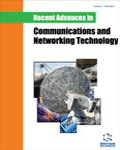Abstract
Networks and communications are the infrastructure on which multimedia and information technologies are built. There are a vast number of networking techniques that depend on the type of multimedia and information technology applications that the network is designed to facilitate. This issue concerns recent communication technologies for transmission, compression, security, and expression of a diverse range of data. In this issue, we discuss how networking techniques are applied in the areas of health, business and transport, which require multimedia and information. This special issue should provide insight into the design of networking technology for applications ranging from sensor networks to broadband networks. The first contribution, published by T. Huynh and W. Hwang, concerns throughput optimization in multicast wireless networks. Various applications, including mobile multimedia, airports, smart homes and audio–video conferencing, require multicast communication to deliver large volumes of data to a group of users. It is important that multiple users receive the same data simultaneously via a reliable transmission network. In this paper, the authors describe an analytical model used to characterize throughput optimization that guarantees the reliability of transmission. In the second contribution, G. Chung and H. Kim introduce digital yarns (or conductive yarns), which enable data transmission. These yarns are particularly interesting in that they can form a crucial element of wearable computing devices, creating a body area network. In particular, smart clothes woven from both ordinary and digital yarns are promising for future applications in many areas of our everyday lives. In this paper, the authors describe the concept of healthwear, with electro cardiogram (ECG) sensors connected using digital yarns. The third contribution is from J. Shim and J. Ko, and discusses the design and implementation of an Ethernet–xBee bridge module for wireless sensor networks, termed Eth2Bee. A wireless sensor network consists of spatially distributed autonomous sensors that monitor physical or environmental conditions, such as temperature, sound or pressure. Eth2Bee can connect wireless networks to the Internet and provide a low-cost gateway technology for the Internet of Things (IoT). The fourth contribution concerns social networking. Yao Meng discusses the use of social media to promote physical activity. In particular, social influence is an effective method of effecting change in attitudes and behavior. She reports a field-study whereby participants used a walking promotion system, which implements workout groups and competition to encourage physical activity. She found that these workout groups, and the associated competition, had a significant effect on the likelihood of participants to use the system. The final contribution to this special issue concerns mobile secure transmission. With the rapid growth of the threedimensional (3D) content industry, 3D mobile secure transmission has recently become important, and digital watermarking and cryptographic protocols have been evaluated. Mobile 3D content, e.g., in mobile 3D games, often requires content security for copyright protection and piracy tracing of 3D graphic models. S. Lee and K. Kwon present a multiple watermarking scheme that uses the anonymous Buyer-Seller watermarking protocol. The method described in this paper can enable copyright protection and measure to prevent illegal copying. Consequently, I sincerely hope that this special issue will be enjoyable and useful to the readers.
 22
22

